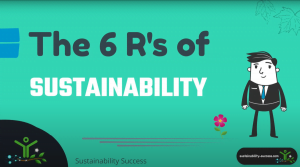With the environment being a growing concern in our lives, the 6 Rs of sustainability are offering an amazing framework to easily achieve a more sustainable lifestyle and all its advantages. But, what are the 6 R’s of sustainability? What’s the meaning of the 6Rs and how they can help us?
The 6 Rs of sustainability are: rethink, refuse, reduce, reuse, repair, recycle. The 6Rs are ordered according to their priority and, If possible, you should prefer actions that appear earlier in the list. Those words are the stepping-stones of more sustainable development and a green lifestyle
Let’s learn more about the six Rs of sustainability and how they can help the planet!
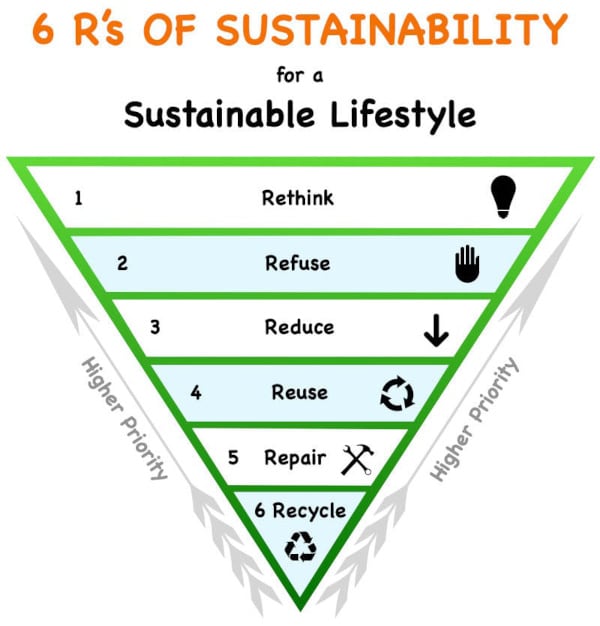
In this article you will learn more about: what’s the 6 Rs definition and what are the 6Rs of sustainability? Some people are also referring to the 3 or 9 R’s, what are they? What’s the concept behind them and how do 3, 6 or 9 Rs help the environment? Are those enough to live a sustainable lifestyle?
In this article, we are going to answer all of those questions and also give you practical 6Rs examples of what the 6 Rs of sustainability mean and how you can use them to become more eco-friendly in your everyday life.
The 6 Rs of sustainability: Introduction
what are the 6rs? 6Rs of sustainability Definition
The 6Rs of sustainability are: rethink, refuse, reduce, reuse, repair, recycle. The 6rs definition can help you to stay on the right path during your eco-living journey.
why are the 6rs important?
The 6 Rs principles or 6Rs of sustainability are important because they represent a sustainable lifestyle framework to help reduce the environmental impact and improve sustainability.
The 6R principle represents important habits that can help us achieve the United Nation’s 17 sustainable development goals (SDG). Nowadays the importance of sustainable development is generally well understood, but still many people are, unfortunately, not taking action to save the planet. In this respect, the 6 R’s of sustainability are playing a very important role, allowing you to lead by example to spread awareness about environmental issues.
We live on a wonderful planet, but with the impending dangers caused by climate change, pollution, loss of biodiversity and the risk of depleting natural resources, many of us have the same goal in mind: to reduce the environmental footprint of humanity and have a more sustainable lifestyle.
Becoming more sustainable in your everyday life can be difficult at times, but it can also be quite rewarding: knowing that thanks to a sustainable lifestyle we are doing our part in preserving the environment for future generations can make us feel more proud of ourselves. If you are new to those topics, we suggest reading our comprehensive introduction to sustainable development and sustainability first.
You probably have already heard about sustainability and the 3 R’s to save the environment: reduce, reuse and recycle. But is this all we can do? Of course not! For this reason in recent years this list has been growing to include additional Rs, becoming the 6R’s of sustainability, the 7 Rs or even the 9 R’s by adding even more to it!
We will look more in detail at the 9 Rs towards the end of the article as they serve mainly to complete and add some more details to the concept already expressed by the first six Rs.
The 6 Rs of sustainability are derived from the concepts expressed by the 3 pillars of sustainability (the 3 Ps), also known as the three E’s of sustainability. In addition, there is also a similar framework named the 4 pillars of sustainability, which emphasizes the human component of sustainability.
1. RETHINK
| 1. Rethink | 2. Refuse | 3. Reduce | 4. Reuse | 5. Repair | 6. Recycle |

What does rethink mean in the 6 r’s? rethink definition 6rs
To understand what rethink means in the six Rs, think about this question: “do I really need that?” This question is beautifully summarising the concept behind the “rethink” principle. This is what you should be asking yourself to start having a more sustainable lifestyle. “Rethink” means that we should all be more mindful of our consumption habits to limit our impact on the environment. This principle is an invitation to rethink our daily choices, realizing that the natural resources of the planet are limited and need to be preserved also for our children.
Rethink is the first of the 6 Rs of sustainability and the one people should look at with the highest priority. Rethinking is so important because it is the first mental step that could help us change the world and save the environment.
For engineers working in product design, rethinking means that you should consider the environmental impact on your design choices. You should be asking yourself questions like:
- Can I design this product in a way that is easier to disassemble, repair, and recycle?
- Is there anything I can change to improve the quality of the product to make it last longer?
- Do I really need to use this material or can I use something more environmentally friendly?
- Can I avoid generating any hazardous waste or at least reduce it to the minimum?
- What can I do to reduce the energy consumption of the product and of its manufacturing process?
- Is there any new green technology I could leverage to make my design more sustainable?
As a product designer, you have a lot of responsibilities and you also have the opportunity to reduce the environmental footprint of your product by making it more energy-efficient, long-lasting, easy to repair and finally easier to recycle.
The definition of “rethink”
The definition of “rethink” can be expressed in two words: think again! It is an invite to reassess an impending choice to make sure that you make the right decision. “Rethink” is a reminder to be more rational in our decisions and consider the environment before taking action.
Most of the purchases in today’s consumerist society are made emotionally: advertisers know this very well and try to leverage human impulses to trigger your purchase in an emotional way. Rethinking is helping you to interrupt this emotional process to allow more rational and environmentally conscious choices. Before taking a decision, stop for a moment to reexamine the potential benefits and especially the ecological consequences of what you are about to do.
7 Examples of “Rethink”: the way to start becoming more sustainable
Here are 7 examples of rethinking that may apply to your everyday life:
- Do I really need that new fast fashion pair of shoes?
- Do I really need to change my phone every other year or can I keep using the old one for longer?
- Do I really need that single-use cup coming from the coffee machine or can I bring my own reusable one?
- Is there anything I can do to avoid buying that single-use water bottle?
- Can I buy local unpackaged seasonal fruit instead of getting that packaged off-season fruit imported from the other side of the world?
- Do I really need that new car? Actually, do I need a private car at all? Can I rent a car when needed instead of owning one?
- Can I use something that I already have instead of purchasing a new product?
PS. By the way, YES, YOU CAN and probably should get rid of that single-use water bottle! Nowadays there are more sustainable alternatives to bottled water, such as purifying tap water directly in your home. Note that there are important differences between purified water vs distilled, but generally, purifying is greener and good for most people (it depends on your personal situation).
Suggested read:
The Sustainable(ish) Living Guide: Everything you need to know to make small changes that make a big difference

★★★★★ 4.7
The Sustainable(ish) Living Guide is an essential read for anyone looking to make a difference in their daily life. With practical tips and down-to-earth advice, this book makes sustainable living accessible and achievable. From reducing waste to choosing eco-friendly products, Jen Gale covers every aspect of our lives, making it easy for high school teachers and students to incorporate sustainable practices into their daily routines. With clear and concise writing, this guide offers a gentle nudge toward making positive changes that can make a big difference.
2. REFUSE
| 1. Rethink | 2. Refuse | 3. Reduce | 4. Reuse | 5. Repair | 6. Recycle |
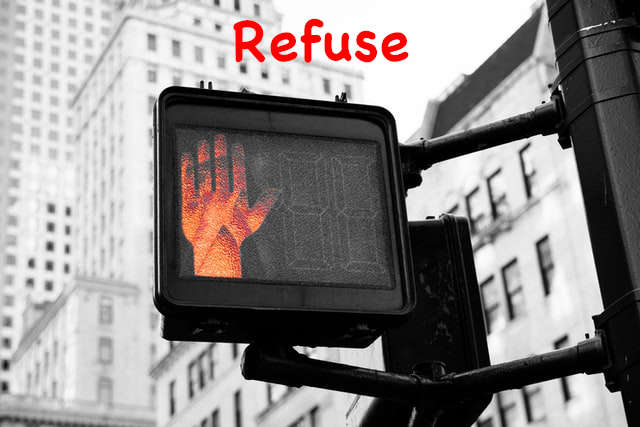
What does refuse mean in the 6 r’s?
“Refuse” means that you should avoid purchasing or even getting for free something that is not essential. The concept should be interpreted in a broad way: by refusing anything that is unnecessary, including items that have excessive packaging, single-use items, or products that are not energy efficient.
Refuse is definitively an important step towards a sustainable lifestyle and is the second of the 6 Rs of sustainability. It represents the second mental and practical stepping-stone after rethinking your consumption habits.
One of the immediate benefits of refusing something we don’t need is to reduce the amount of waste that will end up in landfills. But there is more, in fact, this behavior has the potential to ignite a virtuous cycle by pushing the companies to keep in mind the environment for their design choices. Less demand will lead to a reduction in the production of single-use items and so on for all the items that you are refusing because of environmental concerns.
6 Examples of “Refuse”: how to start a virtuous cycle?
We know that refusing something can be difficult, but you don’t have to start with something that you really want. For example, you can start saying no to small things you don’t really mind about. Then you can slowly build up from there: things are easier once you already started on this path.
Here are 6 examples of how to get started in refusing unnecessary items:
- The next time that you get a drink at the bar, ask to not have a straw. That’s it, you already started to “refuse”! You will still be able to have your drink and at the same time, you will avoid adding that straw to the landfill. Easy, isn’t it?
- The next time you will go to the supermarket bring with you a reusable bag and refuse a single-use one.
- Again, the next time you go to the supermarket, get unpackaged fruit and vegetables and leave the packaged ones on the shelf. Even better, if you can, go to a local fruit and vegetable shop instead of the supermarket: you will not only avoid unnecessary packaging but also reduce the carbon footprint of your purchase by getting some local produce.
- The next time they offer you some free samples of a product you are not really interested in, just say “no thank you”.
- The next time that you have to go to a store just down the road, just go on foot or cycle instead of taking the car. Your health will also benefit as well.
- Log in in your online banking or utility provider and activate the paperless billing. That’s easy, it takes just a couple of clicks and you could improve some sustainability facts by saving some trees as well as reducing the CO2 emissions related to the production and transport of your future bills and bank statements.
Those are just a few of the simple actions you could start taking right away. It will cost you nothing, but the environment and future generations will be grateful.
3. REDUCE
| 1. Rethink | 2. Refuse | 3. Reduce | 4. Reuse | 5. Repair | 6. Recycle |

Reduce means to cut down on the number of products you buy and use. Do you really need that wardrobe full of clothes that you almost never wear? Probably not, in this case, you should consider reducing the number of things you purchase and eventually donate or sell the items you are not using.
Reduce is the third of the six R’s of sustainability and also the first of the 3R’s. As such, “reduce” represents a fundamental and practical step towards reducing your environmental footprint. This action is generally a direct consequence of the first two of the 6 R’s, in fact, the decision to reduce consumption or not buy something will usually come after rethinking about it, and after deciding to refuse something or a new purchase you don’t really need.
For a more sustainable lifestyle, we should all be reducing our consumption to only what is necessary. Cutting down on our consumption habits can be hard at first, but, in the end, it is just a different state of mind: in most cases, we can get rid of many superfluous items without any impact on the quality of our life. The environment needs your help and those products you own but never use could instead be used by someone else: reducing the production of new unnecessary items and the consequent waste of natural resources.
From a product design point of view, “reduce” is also a very important step to consider. For example, you can ask yourself those types of questions:
- Can I design the same component by using less material?
- Can the production use less energy?
- Can I reduce the expected maintenance of this product by improving the design in some areas?
7 examples of reduce
Here are 7 examples of what you can do to reduce your consumption without significantly impacting your life:
- In some cases, you can “reduce” even without limiting your purchases. For example, buying in bulk is generally reducing packaging waste. Just be sure to not buy more than you need.
- Unplug devices that are on standby. This sounds like a very small step, but if you multiply that for millions of devices that are on standby, we probably have about a few power plants in the world that are running just to keep that little and unnecessary red light on!
- Switch off the lights when you are not in the room. It will save you some money and avoid wasting energy as well.
- Avoid buying more food than what you can reasonably eat, because it may spoil and get wasted.
- Avoid buying that new shirt if you already have plenty. Moreover, consider eventually reducing your wardrobe.
- Avoid maxing out the heating to stay in short sleeves at home in winter. You can have similar comfort by simply wearing a jumper and reducing the heating. You will save some money as well!
- Reduce the energy consumption of your house: for example, you can start with simple things like replacing that broken light bulb with a new long lasting and energy efficient LED light.
- Use cruise control to reduce your gas consumption when driving your car for a long commute.
- Consider the pros and cons of Drive Safe and Save, this can not only reduce the cost of your insurance but also help you to save gas.
4. Reuse: What Does Reusing Mean?
| 1. Rethink | 2. Refuse | 3. Reduce | 4. Reuse | 5. Repair | 6. Recycle |

What does reusing mean? You may be asking yourself. Reuse means that you should consider potential ways to use again an old item instead of getting rid of it. This new use could be to fulfill the same task or something completely different. By reusing, instead of throwing something away, you are able to make use of an item over and over again, potentially for multiple years and to benefit different areas of your life.
The importance of “reuse”: it plays a vital role in the 6 Rs of sustainability, so much so that it is also part of the shorter 3 Rs to save the environment list!
The definition of reuse is simply to use again. Give a new life to old products that can still have some utility, avoiding those to end up in landfill. Reusing will also prevent producing a new item just to fulfill a function that can be performed by what you already have.
Another important observation is that you can also think about someone else that may like to reuse the item. If you just don’t want that item anymore but it can still be good for something, consider donating it to a local charity or anyone else that may be interested in it.
You can also try to sell unnecessary items on eBay or on the Facebook marketplace: you may be surprised to know that there actually is a market related to upcycling and finding new uses for old items. For example, when moving home, I was able to sell an old empty champagne bottle on eBay to someone that needed it for some artwork. So you may even be able to raise some cash from your old items!
The initial driver of reuse was financial: you can save money by reusing something rather than buying a new product. In recent years instead, there has been a growing emphasis on environmental issues and with the inclusion of “reuse” in both the 3 and 6 Rs of sustainability, the concept and practice of reusing became increasingly popular.
Another way to reuse is: Repurpose
As noted above, another way to reuse an item is by actually repurposing it to do something different from what it was originally produced for. For example, instead of throwing in the bin that empty bottle of wine, it could be repurposed as an ornament. Essentially, “Repurpose” is a concept that allows extending the life of an item in more creative ways.
Repurpose can be seen as a sort of synonym of reuse, but it has a more specific meaning because the new application has to be different from the original one. Reuse is instead a more general concept allowing to use an item for the same or a different task.
This word didn’t really make it into the popular list of the 6 Rs of sustainability, because its meaning is essentially included in the concept of reusing.
5 Examples of reuse: How to “reuse”?
How to reuse? Here are some examples of “reuse” or “repurpose” that can help you take action now for the environment:
- Are you thinking to bin that old blanket you just found in your wardrobe? Why not reusing it by donating it to a local charity for homeless people or to an animal shelter instead? Your item will not end up in a landfill and the homeless or the animals will be grateful for your gift!
- Reuse that nice wrapping paper. Christmas 2021 is coming, why not save the wrapping paper of the gifts you will receive and reuse it next year? This is also something that my grandmother used to do!
- Reuse glass jars to keep some food like pasta or rice. Even better, use them to keep your homemade jam or tomato sauce.
- Instead of throwing away your old toothbrush, give it a bit more life by reusing it as a cleaning brush. With it you will be easily able to reach and clean areas such as the drain of your sink.
- If you are into self sustainability and have a garden, coffee grinds can be reused by mixing them with soil as fertilizer and they will also act as a repellent to deter squirrels from eating your tomatoes and other vegetables!
5. REPAIR
| 1. Rethink | 2. Refuse | 3. Reduce | 4. Reuse | 5. Repair | 6. Recycle |
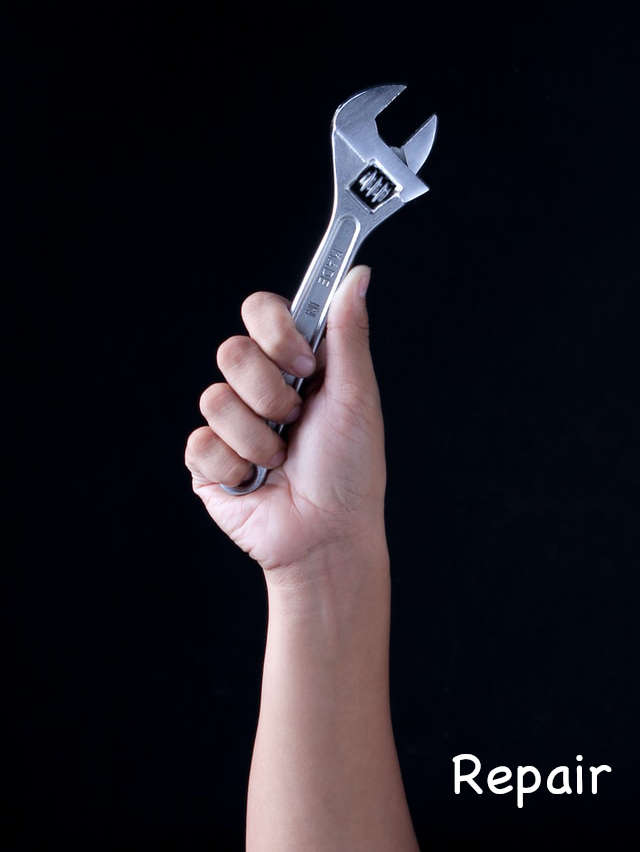
Repair means that, if something is broken, you should first consider repairing it instead of replacing it with a new product. Ask yourself: can I or someone else fix this? Try to use products for as long as you can and dispose of them only if there’s really nothing else you can do. This is the essence of “repair”, the fifth of the 6 Rs of sustainability. “Repair” is one of the last steps you should consider, and only after you already did “rethink”, “refuse”, “reduce”, “reuse” an item.
You may have started to notice a pattern here: the final target of most of the 6 Rs of sustainability so far is to try to use products for as long as possible, coupled with a reduced number of items we own and use. In fact, those are two of the cornerstones of a more sustainable lifestyle. It doesn’t end here of course, because things can not always be repaired.
2 examples of repair
Let’s look at just a few examples of “repair” before we move on to the last of the 6 Rs of sustainability:
- Your phone is now 2 years old and the battery is not lasting. Can you repair it by just replacing the battery instead of buying a new phone?
- Repair your socks if they get an hole. It is not difficult, just give it a try and maybe watch some YouTube videos on how to sew socks if you have no idea of how to do it.
- If your garbage disposal is not working, repair it! And do the same with all of your appliances.
6. RECYCLE
| 1. Rethink | 2. Refuse | 3. Reduce | 4. Reuse | 5. Repair | 6. Recycle |

“Recycle” is defined as the return of items to an earlier stage of the production cycle: usually as raw materials. You should consider this final step only if you can’t reuse or repair the product in the first place. This is why “recycle” is the last of the 6 Rs of sustainability and also the last of the 3 Rs.
Recycling is important and has many benefits, and separating your garbage into things such as paper, plastic, metals, glass, electronics and organic materials is the first very important step that can make recycling materials easier and lead to environmental sustainability. However, in some cases, it’s not possible to avoid waste. For this reason that it is key for everybody to follow and apply as much as possible all of the 6 Rs of sustainability. Recycling is the last attempt to reduce waste and recover any resource that is economically viable to extract from the disposed of product.
The economic aspect of recycling is also very important because it will define what is possible to recover and what is not. For example, most electronic devices have some tiny amount of gold in their components, but this is usually not recovered because it would cost more to do that than to get the same quantity of gold from the market. This is not just an economic reason, usually, when recycling is not economically viable it would cost more energy to extract that resource from the item than to extract it from the planet.
Why Recycling Matters?
Recycling is one of the sustainable business practices necessary for the circular economy. Recycling matters because of several fundamental reasons:
- To reduce the resources we extract from the planet, helping to conserve some of them for future generations. If a material is recycled, then it will be extracted in reduced quantity from the Earth.
- To reduce waste in landfills and keep our water and air cleaner for us and our children.
- To improve the efficiency of human activities. If it’s economically viable to recycle something, then we are improving the efficiency of our businesses by reducing the cost of that raw material.
examples of recycle
If you live in more developed countries, then you are probably familiar with the most common examples of recycling. Those include:
- Recycling paper and baled cardboard. Those items are easy to recycle and avoid having to cut down more trees than necessary. Moreover, you can also recycle cardboard for money.
- Recycling plastics: this is extremely important, because too many plastics still end up in our oceans, polluting the environment and inevitably ending up in our food chain.
- Steel, aluminum, or tin cans can be easily recycled because they can be melted and turned back to new cans or other items.
- Glass bottles and jars can also be recycled and easily turned into new glass.
Examples of other items that could be recycled but where recycling is not yet as common:
- Electronic devices (also known as WEE: Waste of Electric or Electronic devices) can be partially recycled in specialized facilities.
- It is estimated that about 50% of the fabrics that we trow away every year could be recycled. Unfortunately this is still not a common practice.
3 R’s to save the environment: reduce reuse recycle
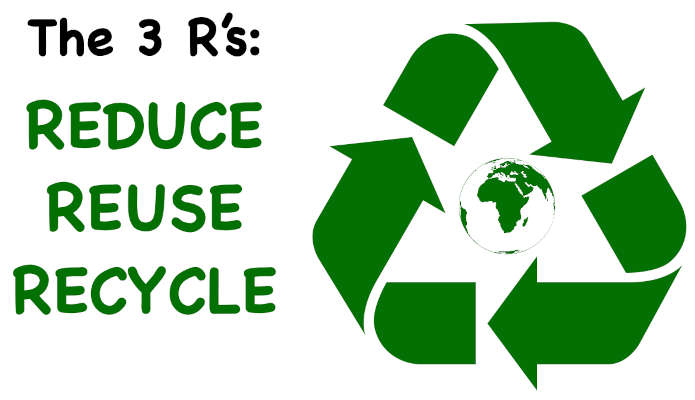
The 3 R’s to save the environment are: reduce, reuse recycle. As mentioned earlier and as you can see, those are just a sub-set of the 6 Rs of sustainability: more specifically, the 3rd, 4th and 6th Rs. This is because the list gradually evolved with time as it became more and more popular. The 3 R’s of sustainability are the three traditional Rs and represent the minimum steps everyone should take to conserve our ecosystem and have a more sustainable life.
Many people often ask how to reduce reuse and recycle: in this article we already gave many practical examples of actions you can take in your daily life to improve your sustainability. For your convenience, here are a few links to the relevant parts of the article:
THE 7 Rs of sustainability And 9 RS: extensions of the 6 Rs model

Recently some further extensions of the list have been proposed, arriving up to the 9 Rs of sustainability.
The 7 Rs of sustainability are just adding “Rot” as the 7th R.
The 9 Rs of sustainability are instead adding “Regift“, “Rent” and “Rot” to the 6 R’s principle.
However, we feel that the concept expressed by those 3 additional Rs are already included in the previous ones. Also, we feel that making this list too long may make it more difficult to keep in mind by the public and even become confusing as there is not a universally accepted list of the supposed 9 Rs. For these reasons, we decided to concentrate our article on the 6 Rs rather than the apparently more “complete” 9 Rs list.
For completeness, let’s also examine the additional 3 Rs and their position in the proposed 9Rs list.
Regift: what’s the definition of regifting?
Re-gift is defined as giving a gift that you received and are not using to someone else. This is a better solution than having that gift sitting in your house without any use or even worse disposing of it. Gifting that item to someone else that may appreciate it more or eventually needs it would be good for both of you and, of course, good for the environment.
If we consider the 6 Rs of sustainability as our reference list, in the 9 Rs “regift” is usually placed in between reuse and repair, so it should be considered after eventually reusing/repurposing the item. Note that others may also place “regift” before “reuse” if they refer more to regifting a new item that was never used.
Regifting may be seen as not nice by someone, especially if the regifted item is presented to the receiving person as a brand new gift for them. If you are going to regift, we suggest simply telling the truth: that you received that gift and while you appreciate it, you are not really using it so you thought that they may like it or need it.
Regifting can also be intended as donating an unwanted or unneeded item to a charity. This would be a very noble act and we would strongly encourage you to do so rather than throwing those items into the bin.
Rent
Renting a product is in general a more sustainable practice than owning. This is because, unless you use the item every day, it will certainly be used more if shared among many people. If your use of a product is relatively limited, then renting is can also have economic benefits compared to owning. One example of this is cloud computing, thanks to which businesses are able to rent the computational resources that they need only when they need them. This can lead to considerable savings compared to buying and maintaining the same product, especially if rarely used.
With the 6 Rs of sustainability as our reference list, “rent” is generally placed before or after “reduce“. As you can see, the placement of those additional Rs to get the 9 Rs is a bit subject to interpretation.
Rot: meaning and why is important
“Rot” is an invite to compost organic materials like food scraps that otherwise would end up in landfills. The result of this process is a nutrient-rich fertilizer that can be used instead of chemical ones. Considering that a large portion of household waste is composed of organic material, rotting can have a large contribution to reducing waste.
In addition, organic “waste” when thrown in a landfill will not become soil, because there are not the right conditions to properly decompose it. On the contrary, this material thrown in a landfill would release methane, which is a powerful greenhouse gas.
The R of “rot” is generally placed at the very end of the 9Rs, because it applies when all of the other points are not applicable anymore.
This R receives particular emphasis in the 2013 book “Zero Waste Home” by Bea Johnson. While we agree with her on the importance of composting food scraps and yard “waste”, we feel that dedicating a specific R to this may be a bit redundant for the public. In fact, in most of the population’s mind, what is described as “rot” by Bea is simply considered recycling, which is already included in the 6 Rs of sustainability!
Conclusion: Living a Zero-Waste Lifestyle

In our opinion, the 6 Rs of sustainability are good enough as they are. They don’t need to be extended to 9 Rs because the additions would be redundant and the concepts expressed are already clear from the original list. In the scientific method, according to Ockham’s razor rule, the simplest theory/model that achieves the desired result is the one that should be adopted.
Regardless of your preferences regarding eventually extending the 6 RS, what really counts is to actually follow them. If you do, you would be living pretty much a zero-waste lifestyle and that’s great news! As we know, going 100% zero-waste is not physically possible, because there will always be something that can’t be recycled, but our objective should be to generate less waste as possible, and the 6R concept is an excellent tool to achieve this!
Applying the 6 rs of sustainability requires the right green motivation, education, and mindset. Getting inspired is paramount to be able to rethink and say no to that new fast fashion pair of shoes preferring more sustainable and ethical options.
Sustainability Success offers the best education on sustainability, sustainable lifestyle, and green technology, and the best part is that it’s free! Take advantage of it and let’s build a better, more sustainable world, starting from simple actions like the ones mentioned in this article.
Are you applying the 6 Rs of sustainability to achieve a sustainable lifestyle? Are you close to a zero-waste life?
Related Topics:

